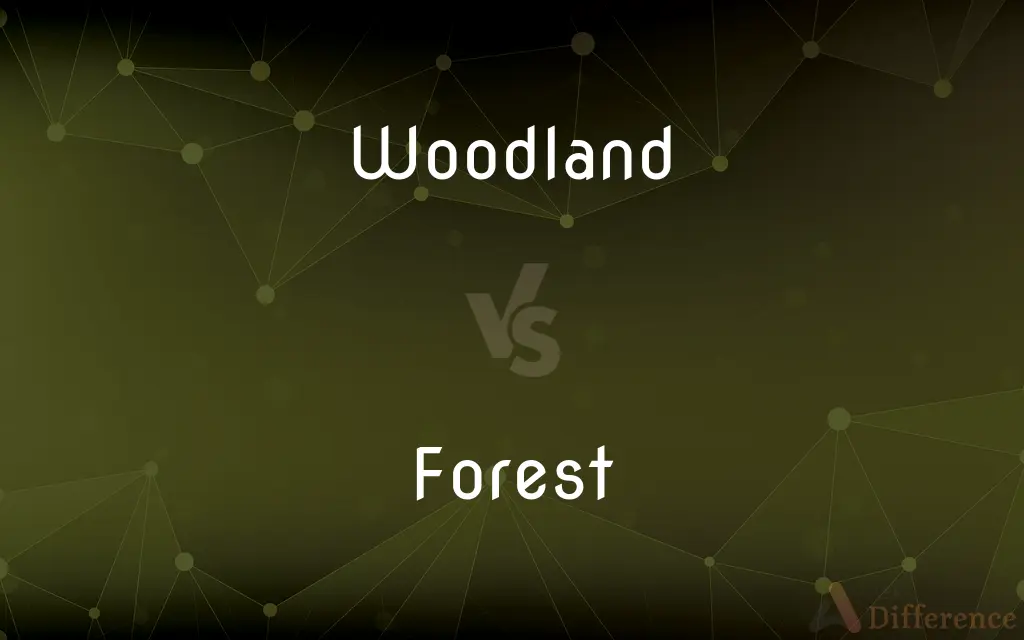Woodland vs. Forest — What's the Difference?
By Maham Liaqat & Fiza Rafique — Updated on March 19, 2024
Woodlands are ecosystems with more open canopies allowing more sunlight, whereas forests have denser canopies with less sunlight reaching the ground.

Difference Between Woodland and Forest
Table of Contents
ADVERTISEMENT
Key Differences
Woodlands are characterized by a more open canopy, which means there's more space between trees. This openness allows more sunlight to penetrate to the ground, fostering a diverse understory of plants and shrubs. Forests, on the other hand, have a dense canopy that significantly reduces the amount of sunlight that reaches the forest floor, limiting the growth of ground vegetation.
In woodlands, the sparser tree population and greater sunlight support a wide variety of grasses and low plants, contributing to a rich biodiversity. Forests, with their dense tree cover, tend to have a different ecological balance, with more emphasis on tree species diversity and a relatively sparse understory due to limited light.
The animal species that inhabit woodlands and forests also differ due to the varying levels of canopy cover and undergrowth. Woodlands, with their mixed habitat, support species that require open spaces or edge environments, while forests provide a habitat for species that thrive in denser cover and can navigate the vertical complexity of the forest.
Management and conservation practices for woodlands and forests take into account their distinct characteristics. Woodland management often involves maintaining the open canopy and diverse undergrowth, while forest management focuses on maintaining tree health, density, and forest structure for biodiversity and sustainability.
Woodlands and forests have been perceived and utilized differently by humans. Woodlands, often easier to navigate and harvest from due to their open structure, have been places for gathering wood, hunting, and foraging. Forests have often been seen as more wild and impenetrable, serving as sources of timber and as important natural reserves.
ADVERTISEMENT
Comparison Chart
Canopy
Open, allowing more sunlight to reach the ground.
Dense, limiting sunlight to the ground.
Understory
Diverse, with grasses and low plants due to more sunlight.
Sparse, with limited ground vegetation due to less sunlight.
Biodiversity
Supports a wide variety of plant and animal species.
High tree species diversity, but less undergrowth diversity.
Habitat
Mixed habitat supporting edge species.
Dense cover supporting species that thrive in thick forest.
Human Use
Historically used for wood, hunting, and foraging.
Viewed as wild, used for timber and conservation.
Compare with Definitions
Woodland
Utilized for wood, hunting, and foraging.
People visited the woodland to gather firewood and hunt game.
Forest
Sparse undergrowth due to limited light.
Few plants could grow on the dark forest floor.
Woodland
Managed for open canopy and biodiversity.
The woodland was carefully managed to prevent it from becoming too dense.
Forest
Focused on maintaining tree health and density.
Forest management included thinning out weaker trees to keep the forest healthy.
Woodland
Supports diverse undergrowth.
A variety of shrubs and grasses thrived in the woodland.
Forest
Dense canopy ecosystem.
The forest floor was dim, shaded by the thick canopy overhead.
Woodland
Open canopy ecosystem.
The woodland was bright, with sunlight filtering through the sparse trees.
Forest
Seen as wild and used for timber.
The forest was mainly accessed by loggers and conservationists.
Woodland
Habitat for a wide range of species.
Deer and rabbits were common in the open areas of the woodland.
Forest
Home to species that prefer dense cover.
The dense forest was a perfect habitat for owls and lynxes.
Woodland
A woodland ( (listen)) is, in the broad sense, land covered with trees, or in a narrow sense, synonymous with wood (or in the U.S., the plurale tantum woods), a low-density forest forming open habitats with plenty of sunlight and limited shade (see differences between British, American, and Australian English explained below). Woodlands may support an understory of shrubs and herbaceous plants including grasses.
Forest
A forest is an area of land dominated by trees. Hundreds of definitions of forest are used throughout the world, incorporating factors such as tree density, tree height, land use, legal standing and ecological function.
Woodland
Of or relating to a Native American culture prevalent throughout much of eastern North America beginning around 1000 BC and lasting especially in northeastern regions until contact with Europeans, characterized by increasing reliance on settled agriculture, by the development of Neolithic crafts and tools, and in certain areas by the building of ceremonial mounds.
Forest
A large area covered chiefly with trees and undergrowth
A pine forest
A large tract of forest
Woodland
Of, relating to, or constituting woodland.
Forest
A large number or dense mass of vertical or tangled objects
A forest of high-rise apartments
Woodland
Living, growing, or present in woodland
Woodland flowers.
Forest
Cover (land) with forest; plant with trees
A forested hillside
Woodland
Land covered with trees.
Forest
A growth of trees and other plants covering a large area.
Woodland
Of a creature or object: growing, living, or existing in a woodland.
The woodland creatures ran from the fire.
Forest
A large number of objects bearing a similarity to such a growth, especially a dense collection of tall objects
A forest of skyscrapers.
Woodland
(obsolete) Having the character of a woodland.
Forest
A defined area of land formerly set aside in England as a royal hunting ground.
Woodland
Land covered with woody vegetation.
Forest
To plant trees on or cover with trees.
Woodland
Land covered with wood or trees; forest; land on which trees are allowed to grow, either for fuel or timber.
Here hills and vales, the woodland and the plain,Here earth and water seem to strive again.
Woodlands and cultivated fields are harmoniously blended.
Forest
A dense uncultivated tract of trees and undergrowth, larger than woods.
Woodland
Of or pertaining to woods or woodland; living in the forest; sylvan.
She had a rustic, woodland air.
Like summer breeze by woodland stream.
Forest
Any dense collection or amount.
A forest of criticism
Woodland
Land that is covered with trees and shrubs
Forest
(historical) A defined area of land set aside in England as royal hunting ground or for other privileged use; all such areas.
Forest
(graph theory) A graph with no cycles; i.e., a graph made up of trees.
Forest
A group of domains that are managed as a unit.
Forest
The colour forest green.
Forest
(transitive) To cover an area with trees.
Forest
An extensive wood; a large tract of land covered with trees; in the United States, a wood of native growth, or a tract of woodland which has never been cultivated.
Forest
A large extent or precinct of country, generally waste and woody, belonging to the sovereign, set apart for the keeping of game for his use, not inclosed, but distinguished by certain limits, and protected by certain laws, courts, and officers of its own.
Forest
Of or pertaining to a forest; sylvan.
Forest
To cover with trees or wood.
Forest
The trees and other plants in a large densely wooded area
Forest
Land that is covered with trees and shrubs
Forest
Establish a forest on previously unforested land;
Afforest the mountains
Common Curiosities
Why does a woodland have more undergrowth than a forest?
The open canopy in woodlands allows more sunlight to reach the ground, supporting more undergrowth.
Are conservation efforts different for woodlands and forests?
Yes, conservation efforts take into account the distinct ecosystems, focusing on preserving biodiversity and sustainability specific to each habitat.
What management practices are unique to woodlands?
Woodland management focuses on maintaining the open canopy and supporting diverse undergrowth.
What distinguishes a woodland from a forest?
The key difference is the canopy cover; woodlands have a more open canopy allowing more sunlight, whereas forests have a dense canopy.
Why might an animal prefer a woodland over a forest?
Animals that prefer or require access to open spaces for feeding or those that thrive in edge environments may prefer woodlands.
How does the dense canopy of a forest impact its climate?
The dense canopy can create a cooler, more humid microclimate within the forest.
How do the animal species in woodlands and forests differ?
Woodlands support species that require open spaces or edge environments, while forests are home to species adapted to dense cover.
What role does sunlight play in the ecology of woodlands and forests?
Sunlight influences plant growth and biodiversity, with more sunlight in woodlands supporting diverse undergrowth, and less in forests leading to a sparse understory.
Can forests and woodlands have overlapping species?
Yes, some species can inhabit both environments, but many are adapted to the specific conditions of either woodlands or forests.
What challenges do forests face that might not affect woodlands as much?
Forests may face challenges like canopy closure leading to reduced biodiversity and increased vulnerability to pests and diseases.
How do woodlands and forests contribute to the global ecosystem?
Both play critical roles in carbon sequestration, biodiversity, and serving as habitats for various species.
Can the transition between woodland and forest be gradual?
Yes, there can be transitional zones where characteristics of both woodlands and forests overlap, creating diverse habitats.
How have humans historically used woodlands and forests differently?
Woodlands were used for gathering wood, hunting, and foraging, while forests were viewed as sources of timber and natural reserves.
What is the significance of managing tree density in forests?
Managing tree density is crucial for maintaining forest health, biodiversity, and preventing wildfires.
What are the educational and recreational values of woodlands and forests?
They offer opportunities for learning about nature, recreation, and experiencing the tranquility of natural environments.
Share Your Discovery

Previous Comparison
Adoption vs. Adaptation
Next Comparison
Hotness vs. HotAuthor Spotlight
Written by
Maham LiaqatCo-written by
Fiza RafiqueFiza Rafique is a skilled content writer at AskDifference.com, where she meticulously refines and enhances written pieces. Drawing from her vast editorial expertise, Fiza ensures clarity, accuracy, and precision in every article. Passionate about language, she continually seeks to elevate the quality of content for readers worldwide.















































